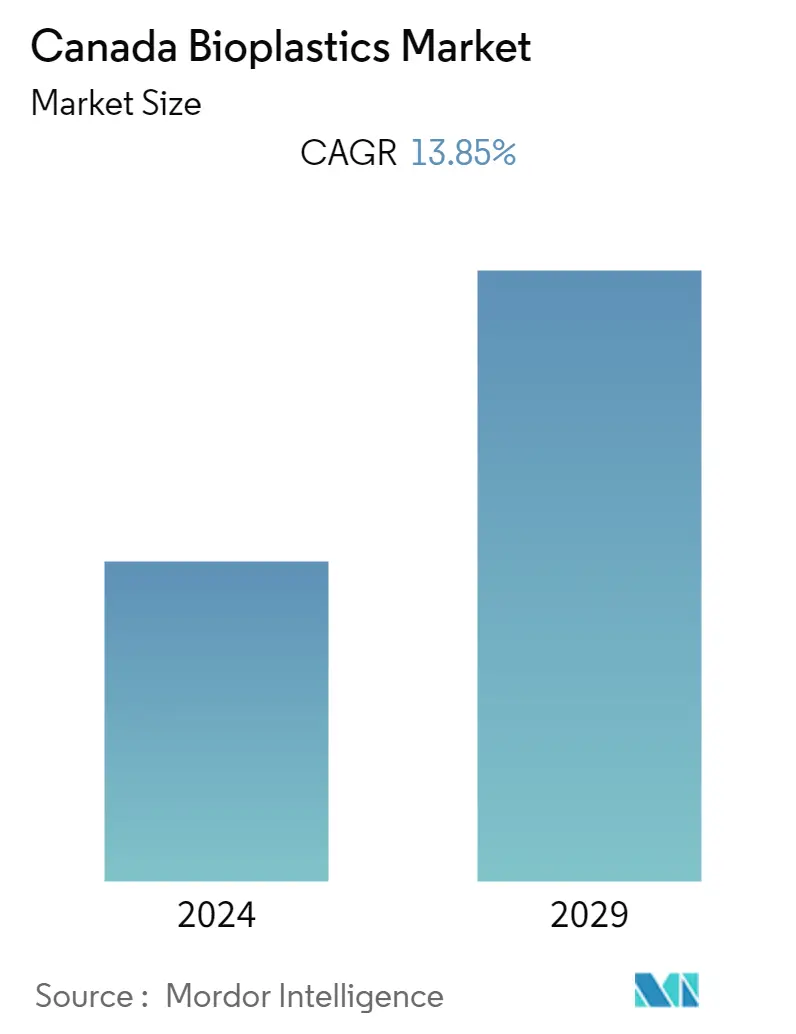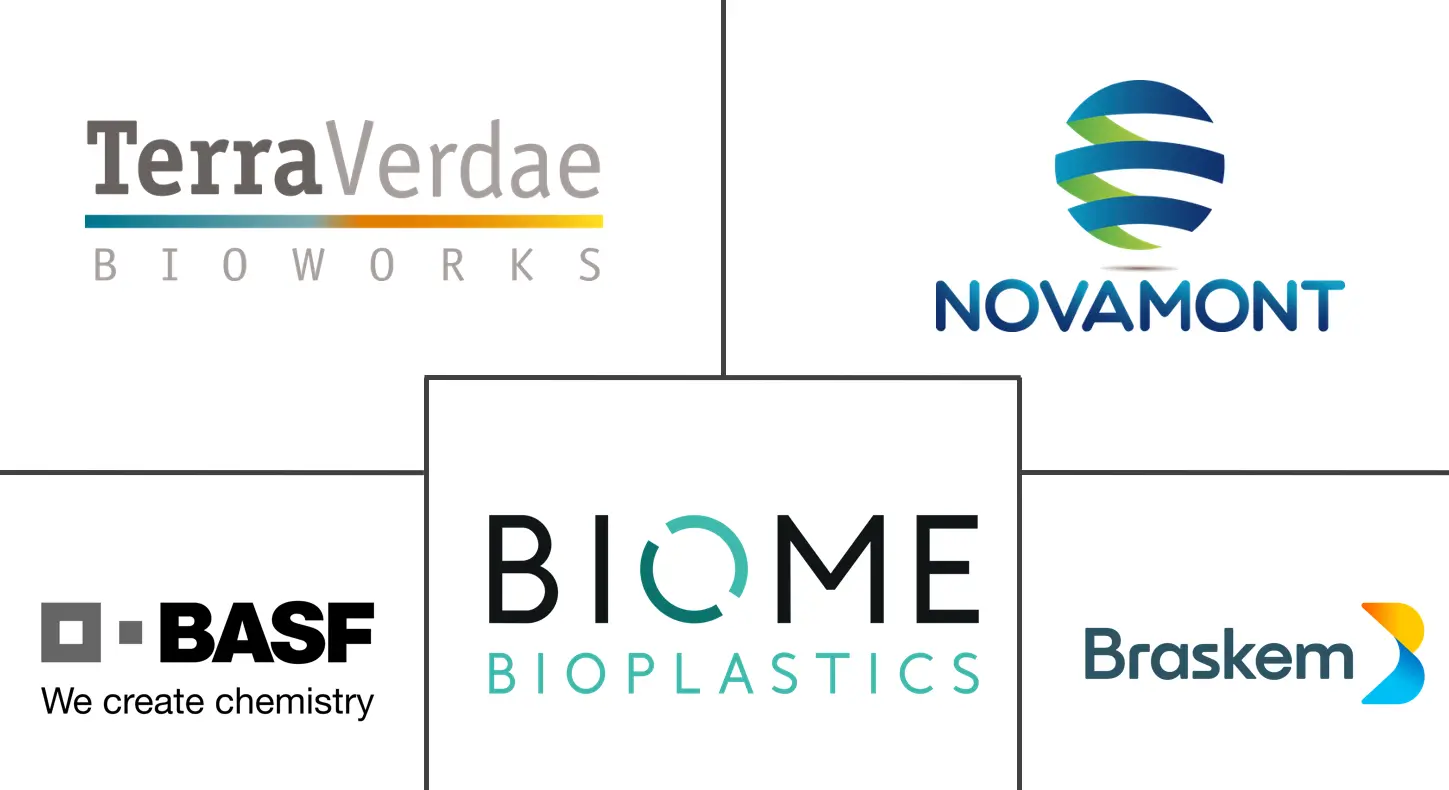Market Size of Canada Bioplastics Industry

| Study Period | 2019 - 2029 |
| Base Year For Estimation | 2023 |
| Forecast Data Period | 2024 - 2029 |
| Historical Data Period | 2019 - 2022 |
| CAGR | 13.85 % |
| Market Concentration | Medium |
Major Players
*Disclaimer: Major Players sorted in no particular order |
Canada Bioplastics Market Analysis
The Canada bioplastics market is estimated to reach 22.31 kilotons by the end of this year and is projected to reach 42.68 kilotons in the next five years, registering a CAGR of 13.85% during the forecast period.
- The COVID-19 pandemic affected several industries negatively. The lockdown in Canada caused disruptions in production, as well as industrial activities, and restrictions on freight transportation, disturbed the supply chain. However, the conditions started recovering in 2021, restoring the market's growth trajectory.
- The rising demand from the flexible packaging segment and favorable regulatory policies in Canada are major factors driving the growth of the market studied.
- However, the availability of cheaper alternatives to traditional plastics will likely restrain the studied market's growth.
- Nevertheless, future prospects in non-packaging solutions are likely to create lucrative growth opportunities for the market.
Canada Bioplastics Industry Segmentation
Bioplastics are plastics produced from renewable sources such as woodchips, sawdust, recycled food waste, corn, and sugarcane to name a few, and can be used as an alternative to traditional plastics to reduce waste and pollution.
The Canadian bioplastics market is segmented by type and application. By type, the market is segmented into bio-based biodegradables (starch-based, polylactic acid, polyhydroxyalkanoates, polyesters, and other bio-based biodegradables (polybutylene succinate (Adipate) (PBS(A)) and cellulose-based plastics)) and bio-based non-biodegradables (bio polyethylene terephthalate, bio polyethylene, bio polyamides, bio poly trimethylene terephthalate, and other non-biodegradables (polyethylenefuranoate (PEF), bio polyols, bio polypropylene, and bio polyurethanes)). By application, the market is segmented into flexible packaging, rigid packaging, automotive and assembly operations, agriculture and horticulture, construction, textiles, electrical and electronics, and other applications (coatings, adhesives, consumer goods, and healthcare).
For each segment, the market sizing and forecasts are provided on the basis of volume (tons).
| Type | |||||||
| |||||||
|
| Application | |
| Flexible Packaging | |
| Rigid Packaging | |
| Automotive and Assembly Operations | |
| Agriculture and Horticulture | |
| Construction | |
| Textiles | |
| Electrical and Electronics | |
| Other Applications (Coatings, Adhesives, Consumer Goods, and Healthcare) |
Canada Bioplastics Market Size Summary
The Canada bioplastics market is experiencing significant growth, driven by increasing demand from the flexible packaging sector and supportive regulatory policies. The market is recovering from the disruptions caused by the COVID-19 pandemic, which had impacted production and supply chains. Bioplastics are gaining traction due to their environmental benefits, being used in various applications such as packaging films, food containers, and organic waste collection bags. The Canadian government's initiatives, including financial support for companies like BOSK Bioproducts Inc., aim to promote the development of sustainable alternatives to traditional plastics, further boosting market expansion. Despite the challenge posed by cheaper conventional plastic alternatives, the market is poised for growth, particularly in non-packaging applications.
The demand for bio-based products, such as Bio-PET, is on the rise as companies and consumers seek to reduce reliance on fossil fuels. Bio-PET is widely used in bottling and packaging, with efforts underway to develop a fully bio-based version. Strategic partnerships among major companies, including Coca-Cola and Procter & Gamble, are accelerating this development. The market is partially fragmented, with key players like Braskem and BASF SE leading the charge. Recent certifications and government funding initiatives, such as the Afri-Plastics Challenge, highlight the ongoing efforts to reduce plastic waste and promote bioplastics. These developments, coupled with increasing consumer awareness and demand, suggest a promising outlook for the Canadian bioplastics market.
Canada Bioplastics Market Size - Table of Contents
-
1. MARKET DYNAMICS
-
1.1 Drivers
-
1.1.1 Growing Demand for Bioplastics in Flexible Packaging
-
1.1.2 Regulatory Policies Supporting the Demand for Bioplastics
-
1.1.3 Other Drivers
-
-
1.2 Restraints
-
1.2.1 Availability of Cheaper Alternatives
-
1.2.2 Other Restraints
-
-
1.3 Industry Value Chain Analysis
-
1.4 Porter's Five Forces Analysis
-
1.4.1 Bargaining Power of Suppliers
-
1.4.2 Bargaining Power of Buyers
-
1.4.3 Threat of New Entrants
-
1.4.4 Threat of Substitute Products and Services
-
1.4.5 Degree of Competition
-
-
-
2. MARKET SEGMENTATION (Market Size in Volume)
-
2.1 Type
-
2.1.1 Bio-based Biodegradables
-
2.1.1.1 Starch-based
-
2.1.1.2 Polylactic Acid (PLA)
-
2.1.1.3 Polyhydroxy Alkanoates (PHA)
-
2.1.1.4 Polyesters (PBS, PBAT, and PCL)
-
2.1.1.5 Other Bio-based Biodegradables (Polybutylene Succinate (Adipate) (PBS(A)) and Cellulose-based Plastics)
-
-
2.1.2 Bio-based Non-biodegradables
-
2.1.2.1 Bio Polyethylene Terephthalate (PET)
-
2.1.2.2 Bio Polyethylene
-
2.1.2.3 Bio Polyamides
-
2.1.2.4 Bio Polytrimethylene Terephthalate
-
2.1.2.5 Other Non-biodegradables (Polyethylenefuranoate (PEF), Bio Polyols, Bio Polypropylene and Bio Polyurethanes)
-
-
-
2.2 Application
-
2.2.1 Flexible Packaging
-
2.2.2 Rigid Packaging
-
2.2.3 Automotive and Assembly Operations
-
2.2.4 Agriculture and Horticulture
-
2.2.5 Construction
-
2.2.6 Textiles
-
2.2.7 Electrical and Electronics
-
2.2.8 Other Applications (Coatings, Adhesives, Consumer Goods, and Healthcare)
-
-
Canada Bioplastics Market Size FAQs
What is the current Canada Bioplastics Market size?
The Canada Bioplastics Market is projected to register a CAGR of 13.85% during the forecast period (2024-2029)
Who are the key players in Canada Bioplastics Market?
Biome Bioplastics Inc, BASF SE, Novamont SpA, Braskem and TERRAVERDAE BIOWORKS INC. are the major companies operating in the Canada Bioplastics Market.

